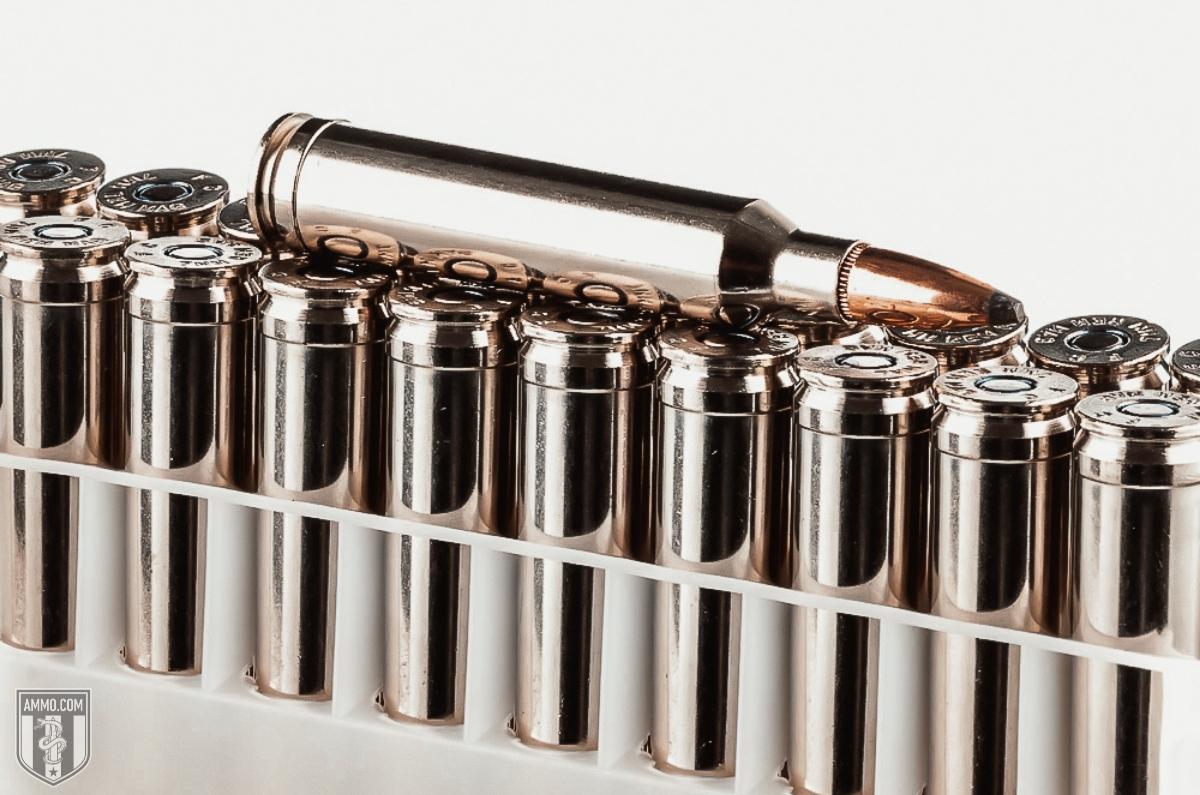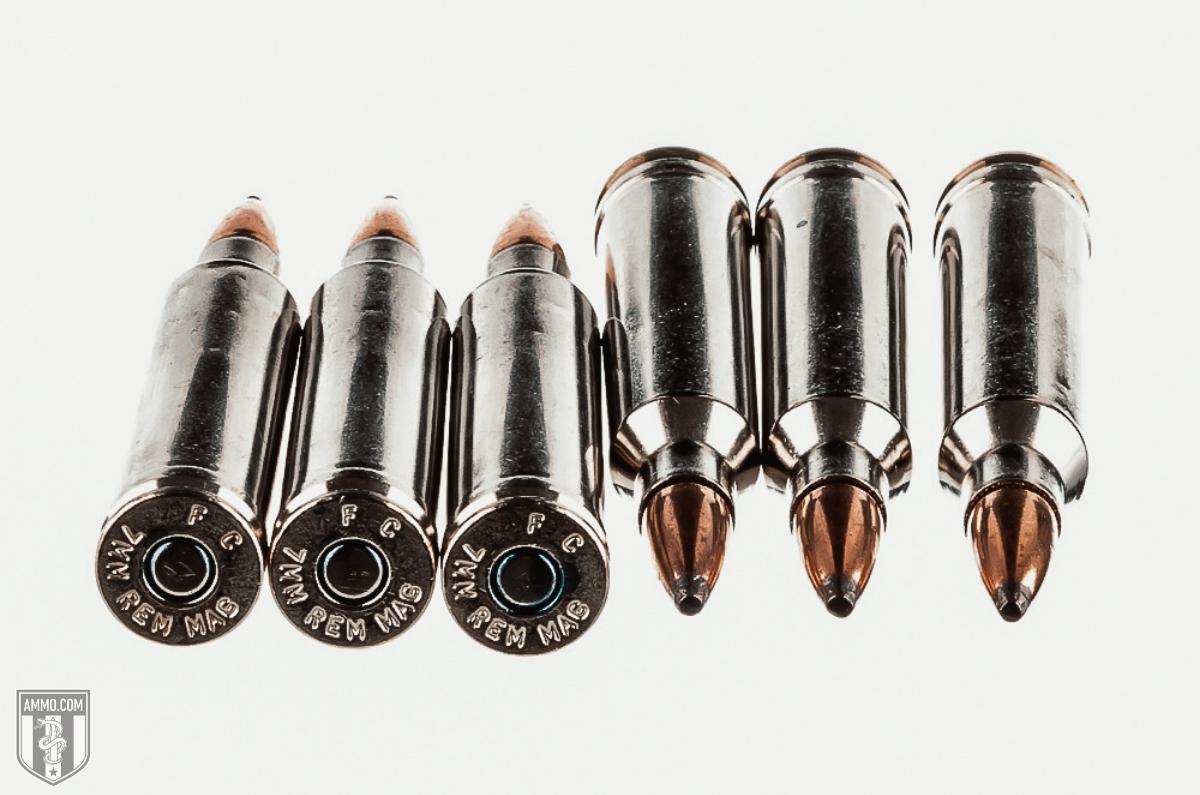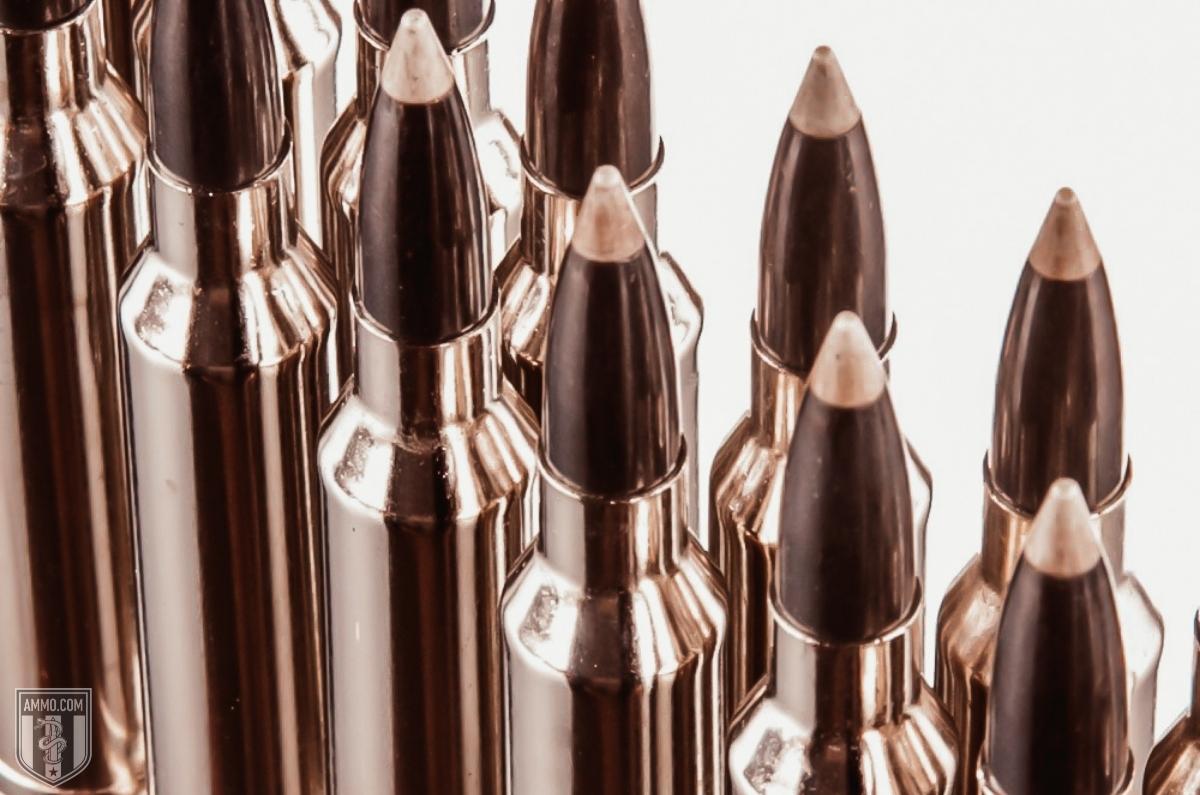6.8 Western vs 7mm Rem Mag vs .28 Nosler: Long-Range Big Game Rivals
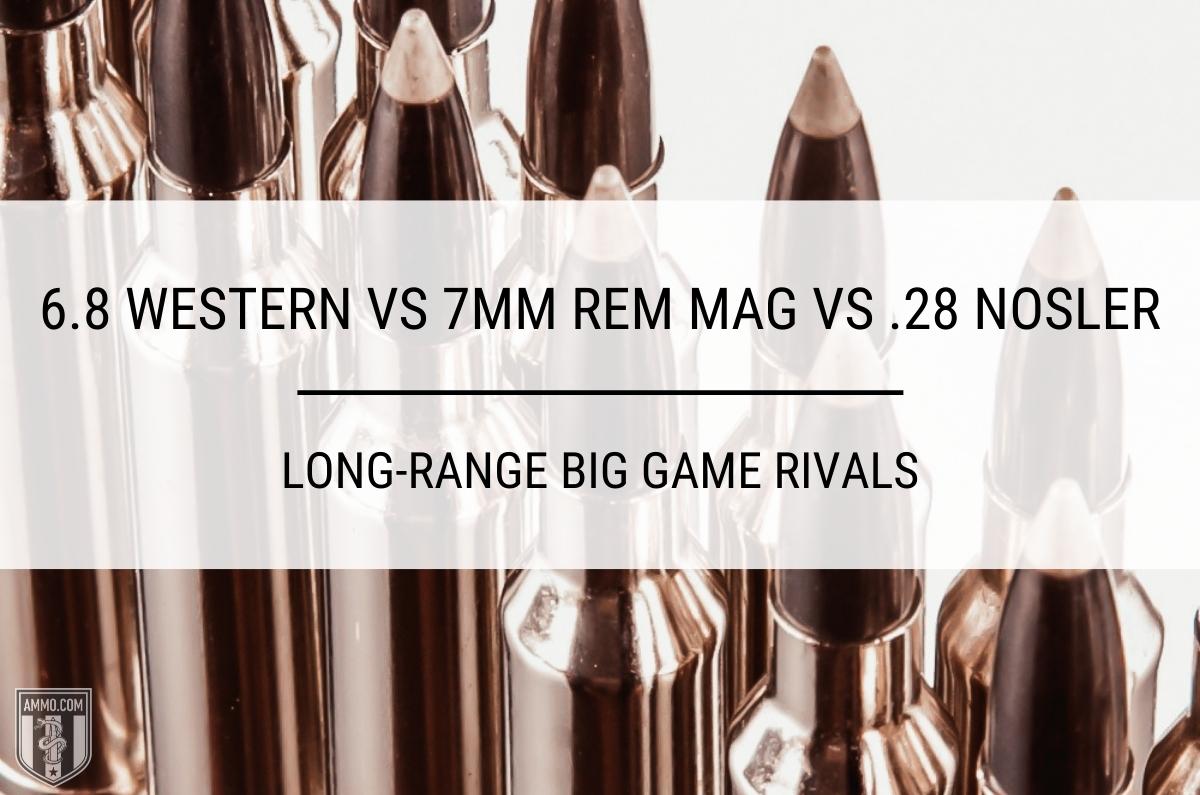
The 7mm Remington Magnum is one of the most popular magnum cartridges in current production. Versatile and dependable, this old-school cartridge managed to overcome the American shooter’s aversion to the metric with its incredible long-distance ballistic capabilities.
However, the 7mm Rem Mag has been around for a long time (since 1962 to be exact), and the wheels of ammunition innovation haven’t stopped turning. Could a newer long-range ballistic superstar dethrone this popular old-timer?
In terms of long-range hunting cartridges, the 6.8 Western vs 7mm Rem Mag vs .28 Nosler match-up is a good one.
If you’re a big game hunter going after long-range sheep, elk, or antelope, is it worth pursuing one of the newer hotrod cartridges like the 6.8 Western or the .28 Nosler? Or should you stick with a safe option, like the tried-and-true 7mm Rem Mag?
In this article, we dive into a deep analysis of the ins and outs of these solid long-range performers.
Cartridge Comparison: .28 Nosler vs. 7mm Rem Mag vs. 6.8 Western
Important details about specific cartridges often get lost in the shuffle of heated ammo debates, especially debates about long-range hunting cartridges. The first step to truly understanding a cartridge’s capabilities is to take a close look at its specs.
Cartridge Specs
Stand these cartridges side by side, and the physical differences are immediately evident. Both the 7mm Rem Mag and .28 Nosler tower over the 6.8 Western. That is because the 6.8 Western was engineered to function in a short-action rifle.
The .28 Nosler has the largest case capacity of this group, while the 6.8 Western has the smallest.
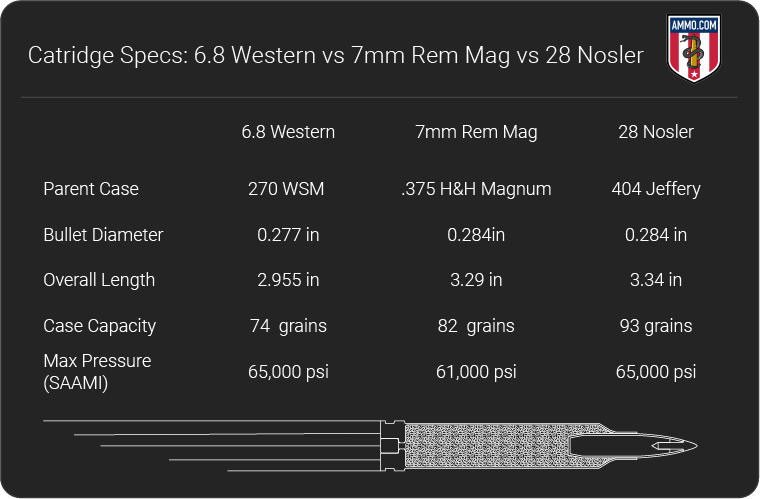
Another difference is bullet size. What caliber is 7mm Rem Mag? The 7Mag and .28 Nosler both use .284-caliber projectiles.
Meanwhile, the 6.8 Western uses a smaller .277-caliber bullet.
7mm Rem Mag factory loads feature bullets weighing between 139 and 175 grains with the 175-grain bullet being the most common. The .28 Nosler shoots bullets in the 150-185 grain family. Meanwhile, 6.8 Western cartridges are topped with much lighter projectiles, usually in the 130-150 grain range. However, those light bullets are actually heavy compared to what other .277 caliber cartridges shoot.
Recoil
There are tons of factors that influence felt or perceived recoil, including the weight of the rifle and the shooter. Plus, some people just seem to handle recoil better than others.
However, if we look at recoil energy and velocity, which are determined by basic mathematical formulas, we can get a good idea of how these three cartridges compare to one another.
None of these cartridges would ever be considered mild in the recoil department. Out of the three, the Nosler will definitely be more brutal on your shoulder. It produces a whopping 33 percent more recoil energy than the softer shooting 6.8 Western. The 6.8 Western definitely has less recoil than the .28 Nosler, but the difference in the 7mm Mag’s recoil is relatively minimal.
However, 6.8 Western isn’t a mild cartridge by any stretch. Compared to other .270-caliber cartridges, it kicks like an absolute mule. The next hardest hitter that pushes a 6.8mm projectile is the .270 Weatherby Magnum, which at 21 ft-lbs of recoil energy is a veritable kitten in comparison.
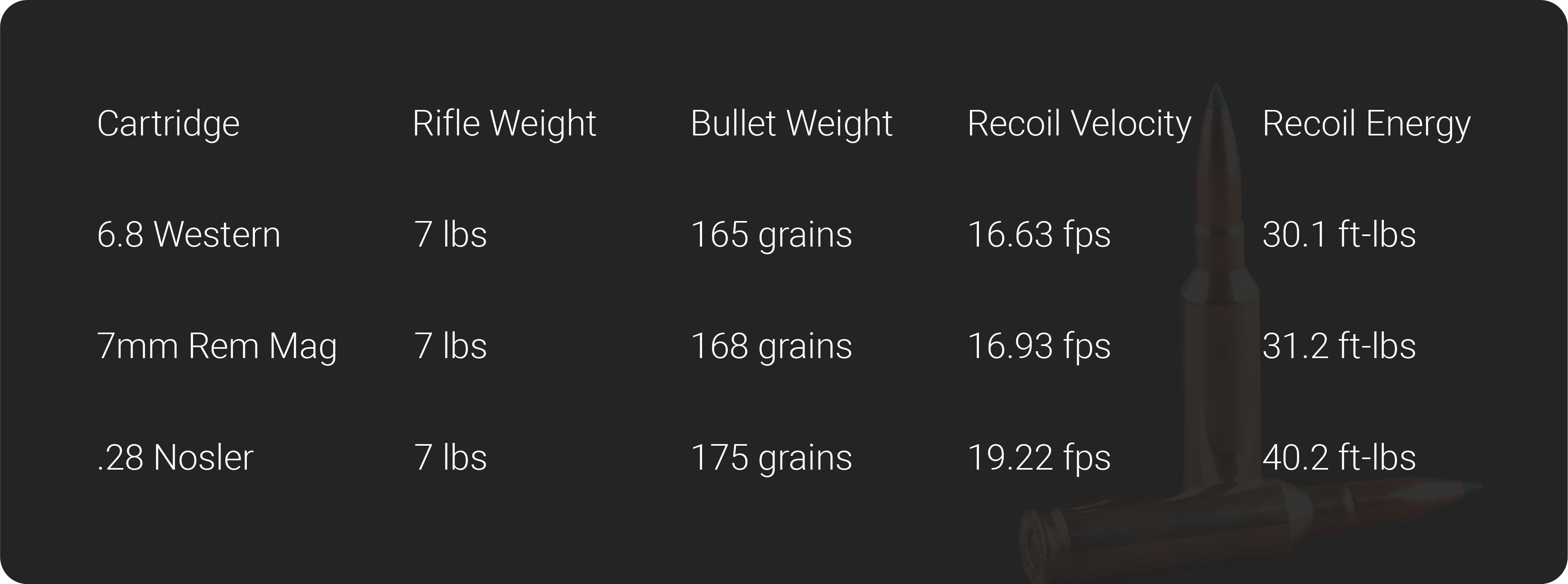
The .28 Nosler is definitely the most brutal cartridge in this comparison. However, it isn’t any more brutal than most other Magnum loads slinging 7mm projectiles. Its recoil is certainly burly, but it isn’t impossible to shoot. It just doesn’t make for a super fun day at the range, and if you’re at all recoil sensitive, you might want to just pass on this one altogether.
Velocity/Trajectory
In terms of velocity, none of these three cartridges is a slouch. Their bullets leave the muzzle screaming, and their high BCs make them slow to shed velocity. That means their trajectories are all similarly flat.
Here’s a quick look at the cartridges’ bullet drop over distance. Each riflescope used in the test had a 200-yard zero.
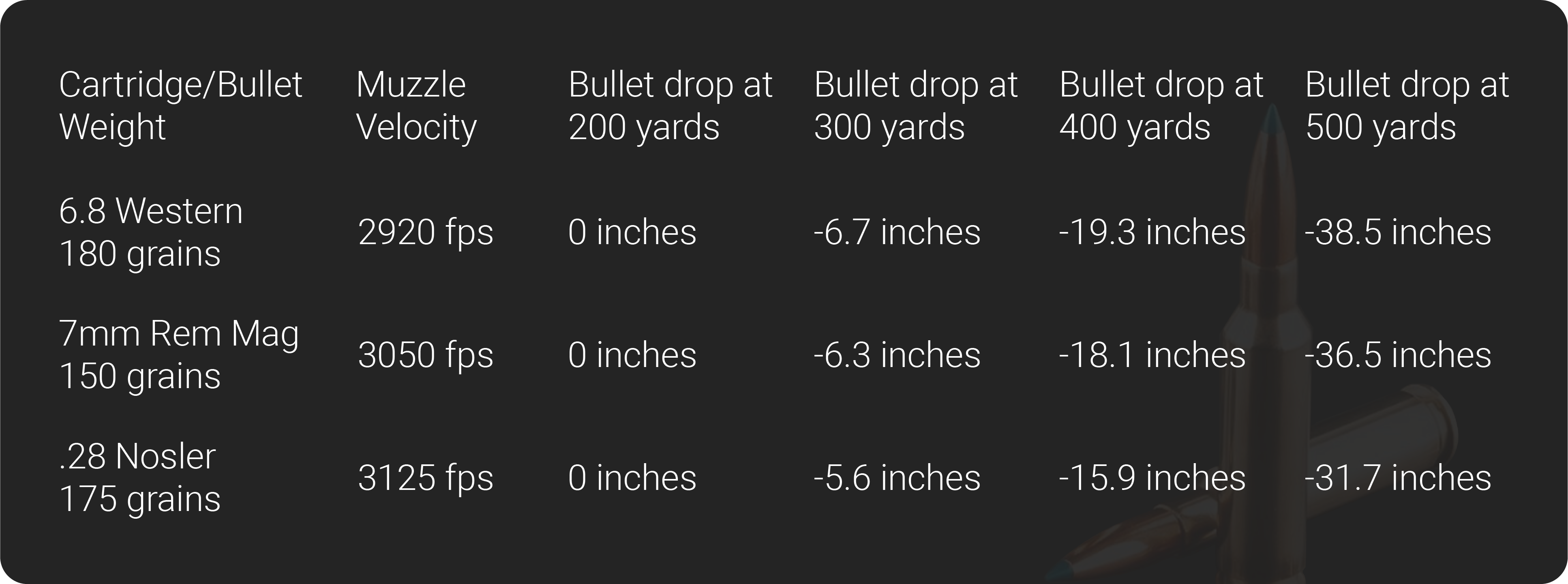
As you can see, the trajectories are all fairly similar, with the 7mm RM having a slight edge over the 6.8 Western. The .28 Nosler outperforms them all, with almost 7 inches less drop at 500 yards than the 6.8 Western and almost five inches less than the 7mm Rem Mag.
Accuracy
Crowning one of these three cartridges as the winner in accuracy is nearly impossible. All of them are capable of sub-MOA groups with a skilled shooter, a good rifle, and quality ammunition.
The effects of recoil on accuracy are often overlooked in cartridge comparisons. Not only can heavy recoil cause even a capable shooter to anticipate the shot, but it also makes it more difficult to recover after that shot is fired.
Taming muzzle rise and getting crosshairs back on target can take some effort. Taking this into consideration, any edge the .28 Nosler might have over the 6.8 Western’s ballistic performance could potentially be made up for with the Western’s much milder recoil.
Ballistic Coefficient
Ballistic coefficient (BC) is a basic concept of physics and is “the ratio of a bullet’s sectional density to its coefficient of form.”
To describe it in more basic terms, BC is simply how well a bullet resists wind and air resistance.
More aerodynamically designed bullets will have a higher BC and will therefore better resist air drag and wind drift.
Ballistic coefficient is like comparing a boxy minivan to a sleek Dodge Viper. Obviously, the Viper’s profile allows it to slip through the air easier at high speeds. In this analogy, the Viper has a higher BC than the minivan.
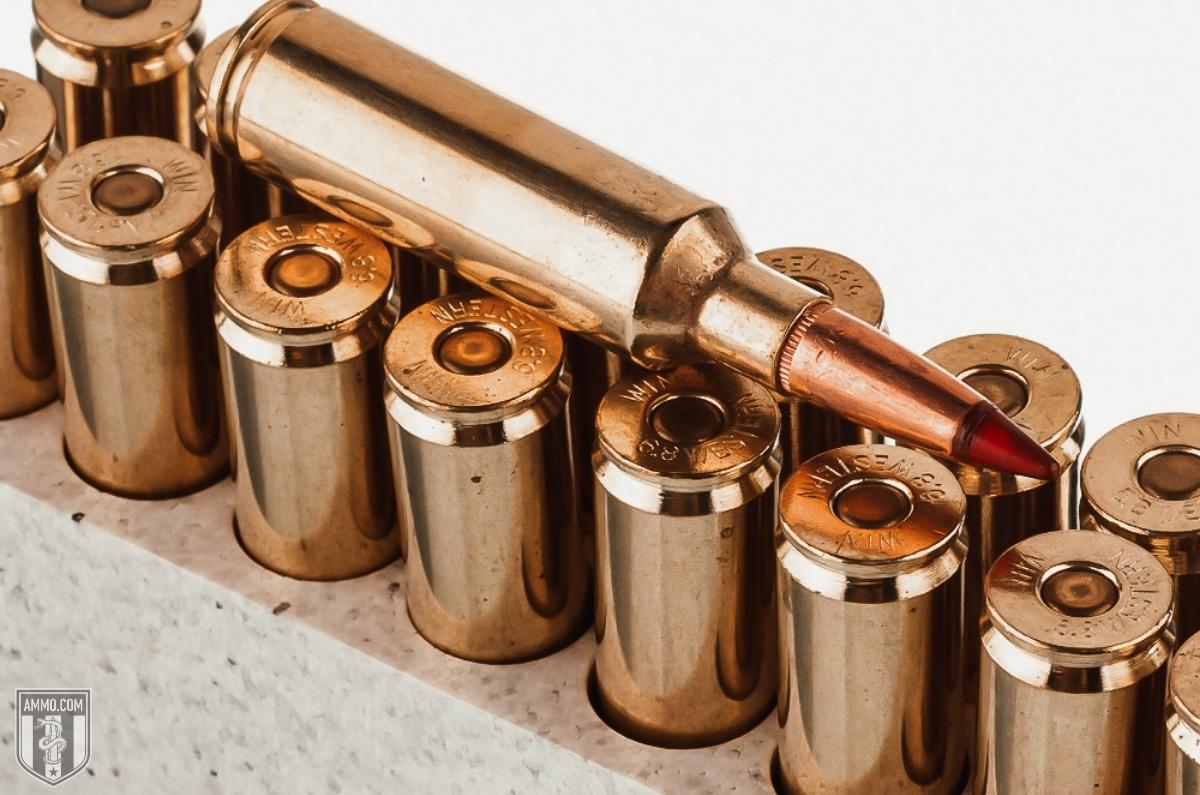
The ballistic coefficients of these cartridges vary and largely depend on the specific bullet design used in each factory load. However, if we use loads that feature a similar bullet design in each cartridge, the smaller diameter of the 6.8 Western will have higher sectional density and a higher ballistic coefficient than the larger diameter bullets used in the 7mm Rem Mag and .28 Nosler loads.
Kinetic Energy/Penetration
Kinetic energy is the energy of motion. If an object is moving, it has kinetic energy. In fact, the faster an object is moving, the more kinetic energy it carries downrange.
It is tempting to oversimplify kinetic energy and think that the faster a bullet is traveling, the more kinetic energy it has. However, it is a little more complicated than that. Mass also plays a role in kinetic energy. That means if you have two projectiles traveling at the same rate of speed, the heavier of the two will have more kinetic energy.
Although 7mm Rem Mag generally delivers faster velocities than 6.8 Western, the Western’s heavier projectiles tend to even out the performance. The 7mm Rem Mag may have a slightly flatter trajectory, but the 6.8 Western carries more energy.
The .28 Nosler, with its hefty bullet weights and lightning-fast muzzle velocities, allow it to outshine them both.

Sectional Density
Although kinetic energy is the energy that drives the projectile into the target, the bullet’s sectional density also affects penetration. A longer, heavier bullet, will have a higher sectional density.
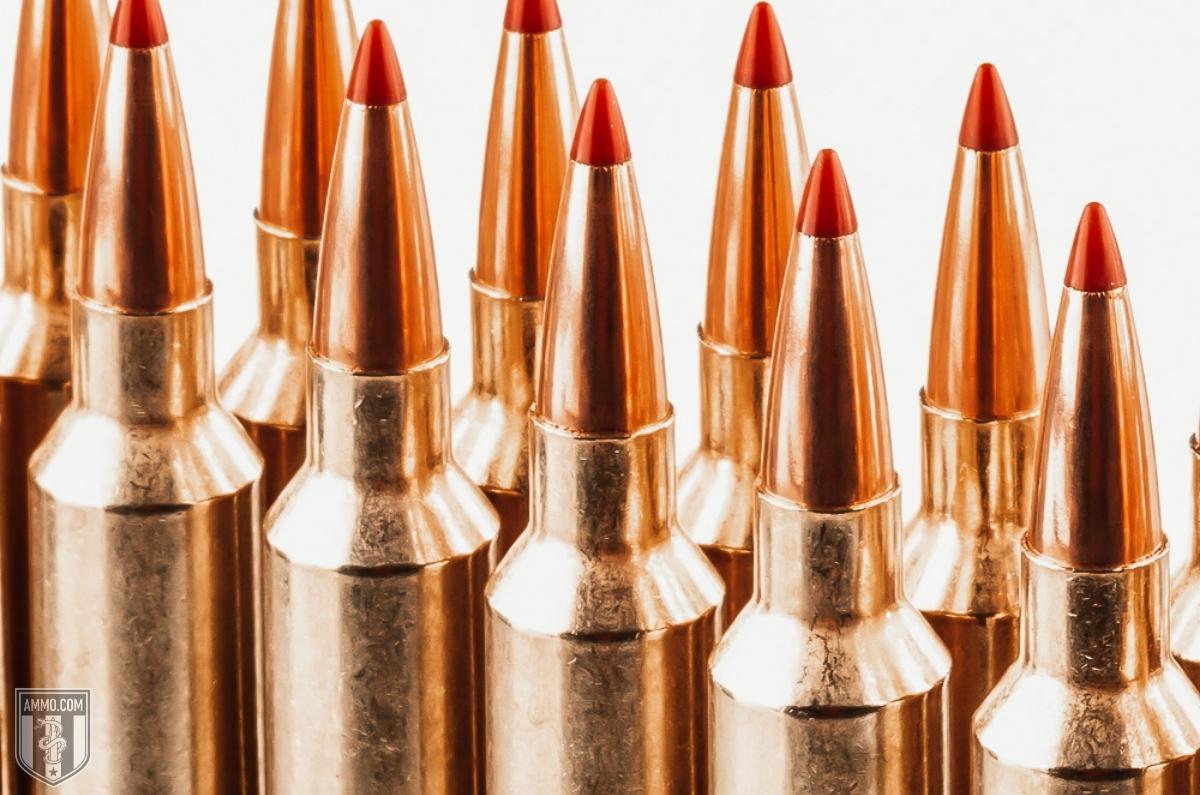
Because the 6.8 Western is pushing bullets that are slim and heavy, it gives this cartridge a slight edge in the sectional density comparison.
Hunting
The fast speeds and flat trajectories of all three of these cartridges makes them a great option for long-range hunting.
1000 ft-lbs of kinetic energy is the generally accepted standard for humanely harvesting whitetail deer and other similarly sized game animals. You’ll need a bit more, usually at least 1500 ft-lbs, to kill larger game like elk and mule deer.
This level of kinetic energy doesn’t guarantee a quick, clean kill. Shot placement and the angle of presentation also come into play. However, these thresholds provide enough energy to aid projectile expansion and drive bullets deep enough to pierce deep-set vital organs.
A bullet carrying a significant amount of kinetic energy will be better able to punch through thick hide and tough bone, which is a major advantage when shooting large or dangerous game animals like elk, moose, and black bear.
By these generally accepted standards of kinetic energy, all three cartridges provide enough stopping power for ethical kills of elk-sized big game out to at least 500 yards.
Sectional density also plays an important role in terminal performance. When two bullets arrive at the target carrying the same amount of kinetic energy, the one with a higher sectional density will drive deeper into the target.
Although the 6.8 Western sports a smaller diameter projectile, its high sectional density can actually cause more tissue damage than the larger 7mm Rem Mag as it drives deep into the animal. When shooting paper targets, the 7mm Rem Mag and .28 Nosler create larger holes. However, the 6.8 Western is capable of carving a deeper wound channel.
Still, shot placement is usually the key to a successful hunt, and the flatter trajectories of the 7mm Rem Mag give it a slight edge over the 6.8 Western. With less bullet drop, the 7mm RM provides a little wiggle room when it comes to range estimation, which can be a huge benefit for hunters popping shots across wide-open spaces.
The .28 Nosler’s impressive velocity, pancake-like trajectory, and energy retention make it the superior hunting cartridge in this comparison. At least on paper. However, the cartridge’s recoil is not for the faint of heart and can take a calm demeanor and more than a little muscle to control. The recoil alone will be enough to make most shooters shy away from the .28 Nosler.
Ammo and Rifle Cost/Availability
When it comes to ammo and rifle cost and availability, the 7mm Remington Magnum easily wins over the 6.8 Western and the .28 Nosler.
7mm Rem Mag is one of the most popular hunting cartridges of all time, partly because of its ballistic performance and partly because it has been around for a long time. All the big-name gun producers have rifles chambered for this popular hunting cartridge. Aside from the classics like the Remington 700 and Winchester Model 70, there are some really awesome offerings from Browning, Ruger, Mossberg, and Weatherby.
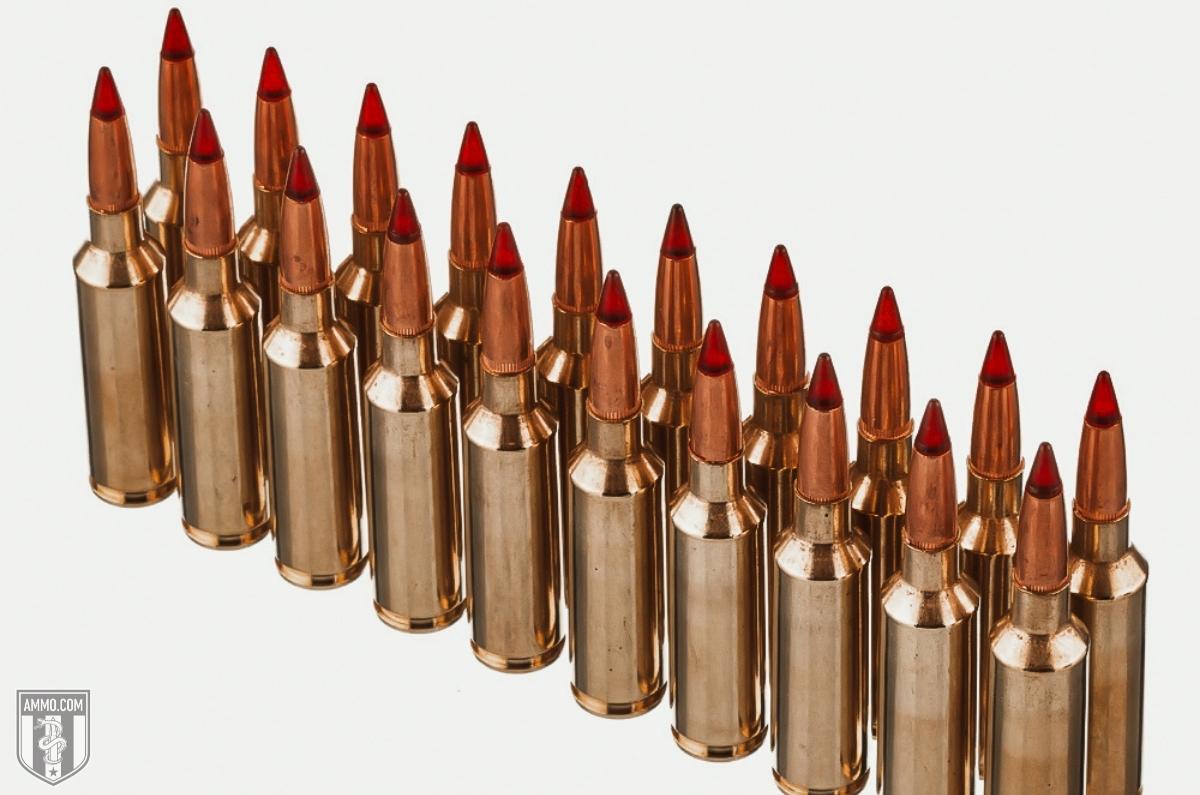
Also, because the 7mm Rem Mag is so widely used, you’ll find a variety of 7mm Rem Mag factory ammo from every major manufacturer in the industry. Hornady, Winchester, Remington, Federal, Nosler, and Browning all offer 7mm Rem Mag in all of their most popular hunting lines, often in multiple bullet weights. You’ll find everything from simple, trustworthy, tried-and-true Remington Core-Lokt to cutting-edge modern designs like Hornady Precision Hunter topped with high-performance ELD-X ballistic tips.
Because 6.8 Western and .28 Nosler are relative newcomers, there are understandably fewer options in both ammo and rifles. However, if these two long-range hunting superstars continue to gain popularity, we can expect to see more options and lower costs in the near future.
If you want a rifle chambered in .28 Nosler, you’ll probably need to spring for something high-end. Options are even more limited for 6.8 Western. As of this writing, only two major rifle manufacturers - Browning and Winchester - are producing factory rifles for this cartridge.
Reloading
If you prefer handloading, the opportunities for customizing all three cartridges abound. You can choose from a wide variety of bullets specialized for everything from varmints to antelope to North American big game. Options include rock stars like Hornady’s V-Max, ELD-X, and SST, Barnes’ TSX, Nosler’s Accubond and Partition, and Sierra’s GameKing.
The 7mm Rem Mag and the .28 Nosler both use the same diameter bullets (.284 inches). That means you can purchase one lot of projectiles and use them for both cartridges. Other common cartridges that use .284-caliber bullets are the 7mm Mauser, 7mm Weatherby Magnum and .280 Ackley Improved.
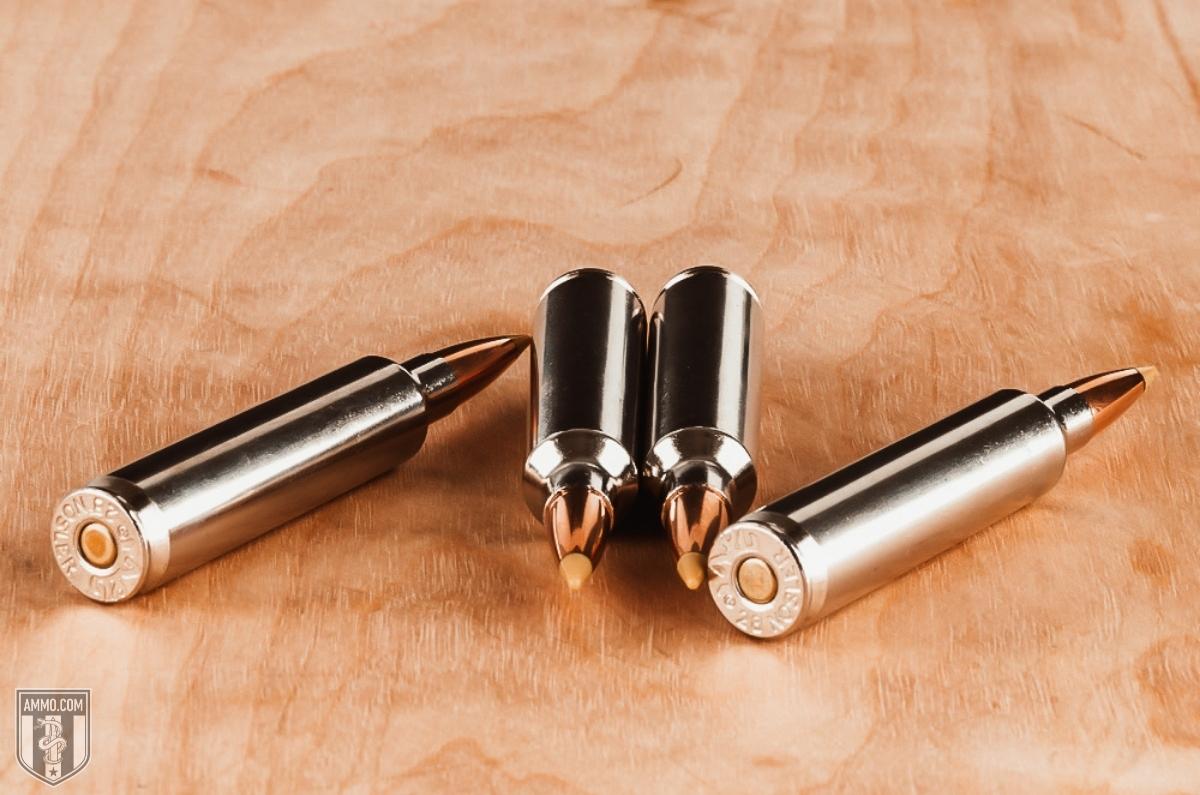
The 6.8 Western uses the same bullets as the popular .270 Winchester, 6.8 Remington SPC, and .270 WSM. Although you can use the same projectiles for handloading all of these cartridges, the 6.8 Western is designed for heavier projectiles and a faster twist rate. To get the best performance out of your handloads, look for bullets that weigh at least 165 grains. 175-grain bullets are highly recommended.
It’s worth noting that finding virgin brass for the .28 Nosler and 6.8 Western can be tricky. You’ll want to save your spent cases for reloading.
7mm Remington Magnum Ballistics
Note: This information comes from the manufacturer and is for informational purposes only. The actual ballistics obtained with your firearm can vary considerably from the advertised ballistics. Also, ballistics can vary from lot to lot with the same brand and type load.
| 7mm Remington Magnum Bullet WEIGHT | Muzzle VELOCITY (fps) | Muzzle ENERGY (ft. lbs.) | TRAJECTORY (in.) | |||||||||||
|---|---|---|---|---|---|---|---|---|---|---|---|---|---|---|
| Muzzle | 100 yds. | 200 yds. | 300 yds. | 400 yds. | Muzzle | 100 yds. | 200 yds. | 300 yds. | 400 yds. | 100 yds. | 200 yds. | 300 yds. | 400 yds. | |
| 139 Grain | 3190 | 2986 | 2791 | 2605 | 2427 | 3141 | 2752 | 2405 | 2095 | 1817 | 1.2 | 0 | -5.7 | -16.5 |
| 139 Grain | 3150 | 2930 | 2710 | 2510 | 2320 | 3085 | 2660 | 2290 | 1960 | 1670 | 2.5 | 2.4 | -2.4 | -12.7 |
| 139 Grain Superformance | 3240 | 3033 | 2836 | 2648 | 2467 | 3239 | 2839 | 2482 | 2163 | 1877 | 1.1 | 0 | -5.5 | -15.9 |
| 140 Grain | 2710 | 2482 | 2265 | 2059 | n/a | 2283 | 1915 | 1595 | 1318 | n/a | 0 | -4.5 | -1.57 | 0 |
| 140 Grain | 3150 | 2930 | 2710 | 2510 | 2320 | 3085 | 2660 | 2290 | 1960 | 1670 | 2.5 | 2.4 | -2.4 | -12.7 |
| 140 Grain BR | 2216 | 2012 | 1821 | 1643 | 1481 | 1525 | 1259 | 1031 | 839 | 681 | 2 | -3.7 | -20 | 0 |
| 140 Grain SA ULTRA MAG | 3175 | 2934 | 2707 | 2490 | 2283 | 3033 | 2676 | 2277 | 1927 | 1620 | 1.3 | 0 | -6 | -17.7 |
| 140 Grain Ultra | 3425 | 3184 | 2956 | 2740 | 2534 | 3646 | 3151 | 2715 | 2333 | 1995 | 1.7 | 1.6 | -2.6 | -11.4 |
| 150 Grain | 3110 | 2830 | 2568 | 2320 | 2085 | 3221 | 2667 | 2196 | 1792 | 1448 | 2.5 | 1.6 | -4.6 | -16.5 |
| 150 Grain SA ULTRA MAG | 3110 | 2828 | 2563 | 2313 | 2077 | 3221 | 2663 | 2188 | 1782 | 1437 | 2.5 | 2.1 | -3.6 | -15.8 |
| 154 Grain | 3110 | 2830 | 2568 | 2320 | 2085 | 3221 | 2667 | 2196 | 1792 | 1448 | 2.5 | 1.6 | -4.6 | -16.5 |
| 154 Grain Superformance | 3100 | 2914 | 2736 | 2565 | 2401 | 3286 | 2904 | 2560 | 2250 | 1970 | 1.3 | 0 | -5.9 | -17.2 |
| 160 Grain | 2950 | 2730 | 2520 | 2320 | 2120 | 3090 | 2650 | 2250 | 1910 | 1600 | 2.5 | 1.8 | -4.4 | -17.8 |
| 160 Grain SA ULTRA MAG | 2850 | 2676 | 2508 | 2347 | 2192 | 2885 | 2543 | 2235 | 1957 | 1706 | 1.7 | 0 | -7.2 | -20.7 |
| 160 Grain SA ULTRA MAG | 2960 | 2762 | 2572 | 2390 | 2215 | 3112 | 2709 | 2350 | 2029 | 1743 | 2.6 | 2.2 | -3.6 | -15.4 |
| 160 Grain Ultra | 3225 | 3035 | 2854 | 2680 | 2512 | 3694 | 3273 | 2894 | 2551 | 2242 | 0 | -2.3 | -8.8 | -20.2 |
| 162 Grain | 2950 | 2730 | 2520 | 2320 | 2120 | 3090 | 2650 | 2250 | 1910 | 1600 | 2.5 | 1.8 | -4.4 | -17.8 |
| 165 Grain | 2900 | 2699 | 2507 | 2324 | 2147 | 3081 | 2669 | 2303 | 1978 | 1689 | 2.5 | 1.2 | -5.9 | -19 |
| 174 Grain Ultra | 3040 | 2896 | 2756 | 2621 | 2490 | 3590 | 3258 | 2952 | 2669 | 2409 | 0 | -2.6 | -9.9 | -22.2 |
| 175 Grain | 2860 | 2645 | 2440 | 2244 | 2057 | 3178 | 2718 | 2313 | 1956 | 1644 | 2.5 | 1 | -6.5 | -20.7 |
6.8 Western Development/History
The 6.8 Western is Winchester’s first metric cartridge and is a relatively new take on the proven .270 Winchester Short Magnum. While the cartridge’s critics complain that the 6.8 Western is just a smart marketing gimmick and little more than a reintroduction of its parent cartridge, it actually produces faster velocities and carries more kinetic energy.
Compared to the .270 WSM, 6.8 Western fires heavier, more aerodynamic bullets. With a higher ballistic coefficient, the 6.8 Western retains more energy as it travels downrange.
7mm Rem Mag Development/History
Although the 7mm Remington Magnum is certainly the most popular 7mm magnum cartridge on the market today, it wasn’t the first. By the time 7mm Mag hit the scene in 1962, the world was already familiar with the 7mm Mauser, which had been used by the Spanish to fire on US troops in Cuba in 1898. The Mauser’s prowess inspired the development of the infamous .30-06 Springfield.
The 7mm Rem Mag cartridge was released in conjunction with Remington’s now-legendary Model 700 bolt-action rifle. The cartridge was based on the belted magnum concept of the .300 H&H and the .375 H&H Magnums. The case has minimal body taper and a sharp shoulder. The design improved cartridge extraction reliability, which is a major asset when hunting large or dangerous game.
Since its introduction, 7mm Rem Mag has become the world’s most popular belted cartridge. It is also one of the top cartridges to ever bear the “magnum” label.
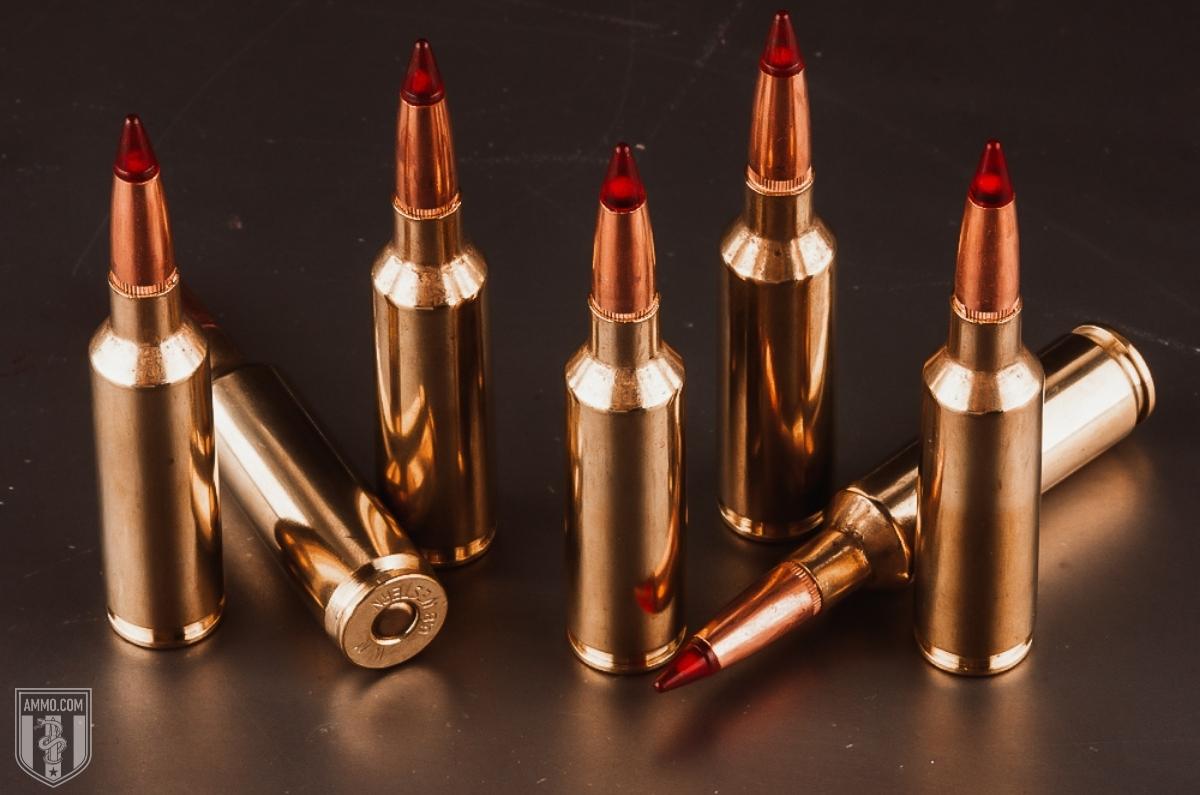
.28 Nosler Development/History
Nosler initially developed a solid reputation in the ammo industry by engineering high-performance hunting projectiles for handloading. Among their legendary projectile line-up are the popular Nosler Accubond and the Nosler Partition.
In 2013, the company dipped its toe into cartridge development and soon after released its first contribution to the cartridge world with the .26 Nosler. The cartridge was modeled after a necked-down 404 Jeffrey case that was shortened to fit in a standard action length.
The cartridge was such a success that Nosler released its second cartridge, the .28 Nosler, in 2015. Like its older brother, the .28 Nosler is built on a necked down, shortened 404 Jeffrey case. As a result, the new cartridge is capable of throwing heavy-for-caliber bullets with a high ballistic coefficient.
Fueled by the success of its first two cartridges, Nosler has released a full line-up of effective hunting cartridges, including the .33 Nosler (2016), the .30 Nosler (also 2016), the .22 Nosler (2017), and the .30 Nosler (2016).
Conclusion: .28 Nosler vs 7mm Rem Mag vs 6.8 Western
The firearms and ammo industries continue to stretch the boundaries of effective shooting through engineering and innovation. That is particularly good news for long-range big game hunters who now have a plethora of capable cartridges to choose from.
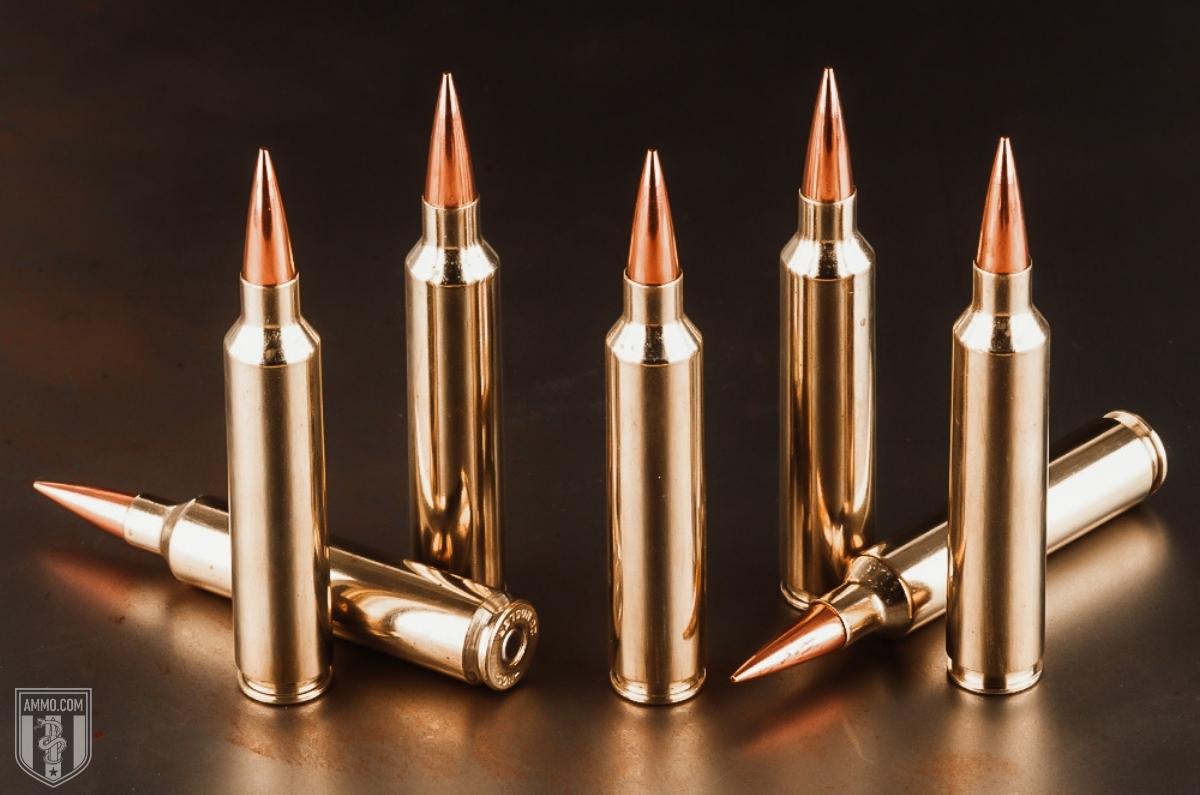
All three cartridges in this comparison are extremely effective on whitetails, especially within typical hunting ranges. Each of these cartridges is also well-suited for hunting caribou, moose, and elk. They are also perfect options for hunting pronghorn or mule deer in open country.
Since all three cartridges are proven and incredibly capable, the 6.8 Western vs 7mm Rem Mag vs .28 Nosler debate is far from easy to settle.
While the .28 Nosler certainly outperforms the others, few hunting situations will actually demand the full scope of the cartridge’s capabilities. Its recoil may also be a deal-breaker, even for some sturdy shooters.
The 7mm Rem Mag offers slightly less impressive ballistics than its two competitors, although it is by no means an underachiever. It not only has a time-tested track record, but it also has a wide variety of affordable and effective rifles and ammo, which is its biggest advantage over the two rookie cartridges.
Ammo Comparisons
- .308 vs 5.56
- 6.5 Creedmoor vs .308
- .300 Blackout vs .308
- .300 Win Mag vs .308
- .243 vs .308
- .308 vs .30-06
- 7mm-08 vs .308
- .270 vs .308
- 7.62x39 vs .308
- .223 vs .308
- .338 Lapua vs .308
- .380 ACP vs 9mm
- .223 vs 5.56
- .300 Blackout vs 5.56
- 9mm vs 45 ACP
- 9mm vs 40 S&W
- .357 SIG vs 9mm
- 10mm vs 9mm
- 9mm vs 9mm Luger
- .243 vs .270
- .300 Win Mag vs .30-06
- .270 vs .30-06
- .40 vs .45
- 38 Special vs 357
- 9mm vs 40 vs 45
- 5.56 vs 7.62x39
- 338 Lapua vs .30-06
- .30-30 vs .30-06
- 300 PRC vs 338 Lapua
- .30-06 vs 7mm
- 300 Win Mag vs 338 Lapua
- 300 PRC vs 300 Win Mag
- 300 WSM vs 300 Win Mag
- 338 Win Mag vs 338 Lapua
- 12 Gauge vs 20 Gauge
- 10mm vs 357 Mag
- .30-30 vs 7.62x39
- 224 Valkyrie vs 22-250
- 17 HMR vs 22 Mag
- 7.62x39 vs .300 Blackout
- 45 ACP vs 45 Auto
- 45-70 vs 30-30
- 300 Blackout vs 223
- 357 Magnum vs 9mm
- 350 Legend vs 300 Blackout
- 224 Valkyrie vs 223
- 45 ACP vs 38 Super
- 6.5 Grendel vs .308
- 17 HMR vs 22 LR
- 10 Gauge vs 12 Gauge
- 22-250 vs 223
- 45 Colt vs 45 ACP
- 350 Legend vs 30-30
- 5.7x28 vs 223
- 5.7 vs 9mm
- 5.56 vs 5.7
- 22 vs 9mm
- Buckshot vs Birdshot
- 450 Bushmaster vs 308
- 450 Bushmaster vs 223
- Buckshot vs Slug
- 6.5 Grendel vs 5.56 vs 223
- 6mm ARC vs 6.5 Grendel
- 44 vs 45
- 458 SOCOM vs 5.56
- 357 vs 44
- 32 ACP vs 380
- 300 Win Mag vs 338 Win Mag vs 338 Lapua Mag
- 450 Bushmaster vs 458 SOCOM vs 50 Beowulf
- 6mm Creedmoor vs 6.5 Creedmoor
- TMJ vs FMJ
- 44 Special Vs 44 Magnum
- 45 90 vs 45 70
- 6.8 Western vs 6.8 SPC
- 50 Beowulf vs 50 BMG
- 26 Nosler vs 6.5 PRC
- 28 Gauge vs 410
- 6.8 SPC vs 5.56
- 6.8 SPC vs 6.5 Grendel
- 6.8 Western vs 7mm Rem Mag vs .28 Nosler
- 6.8 Western vs 6.5 Creedmoor
- 22 Hornet vs 223
- 6.8 Western vs 6.5 PRC
- .410 vs 12 Gauge
- .410 vs 20 Gauge
- 22 LR vs 22 Mag
- 6mm ARC vs 243
- 7mm-08 vs 270
- 243 vs 6.5 Creedmoor
- Nickel vs Brass Casing
- 204 Ruger vs 223
- 50 Beowulf vs 5.56
- 260 Remington vs 6.5 Creedmoor
- 6mm Remington vs 243
- 28 Nosler vs 300 PRC
- 50 Beowulf vs 50 AE
- 22 Nosler vs 22-250
- 450 Marlin vs 45-70
- 300 Win Mag vs 300 Norma
- 458 SOCOM vs 300 Blackout
- 38-55 vs 45-70
- 22 Hornet vs 22 LR
- 300 Norma vs 338 Lapua
- 338 Lapua vs 50 BMG
- 28 Nosler vs 300 Win Mag
- 28 Nosler vs 6.5 Creedmoor
- 204 vs 22-250
- 458 SOCOM vs 45 70
- 44 40 vs 45 70
- 6.8 SPC vs 6.5 Creedmoor
- 450 Bushmaster vs 30-06
- 7mm Rem Mag vs 300 Win Mag
- 30 Carbine vs 223
- 25-06 vs 30-06
- 26 Nosler vs 28 Nosler
- 16ga vs 12ga
- 30 06 vs 7.62 x54R
- 9mm Makarov vs 9mm Luger
- 350 Legend vs 223
- 30 Carbine vs 5.56
- 6.5x55 vs 6.5 Creedmoor
- 6.5 Creedmoor vs 270 vs 25-06
- M193 vs M855
- 450 Bushmaster vs 458 SOCOM
- 6.5 Grendel vs 6.5 Creedmoor
- 350 Legend vs 5.56
- .277 Fury vs 6.8 SPC
- 277 Fury vs 300 Win Mag
- 10mm vs .45 ACP
- 277 Fury vs 223
- 6.8 SPC vs 300 Blackout
- 6.5 PRC vs 6.5 Creedmoor
- 277 Fury vs 308
- 277 Fury vs 6.5 Creedmoor
- 350 Legend vs 450 Bushmaster
- 277 Fury Vs 5.56 NATO
- 10mm vs 40S&W
- 32 ACP vs 9mm
- 32 Special vs 9mm
- 8.6 Blackout vs 300 Blackout
- 30 Super Carry vs. 9mm
- 5.56 vs 9mm
- .50 Action Express vs 9mm
- 7.62x25 vs. 9mm
- 10mm vs 44 Magnum
- 300 Blackout vs 300 Win Mag
- 6.5 Grendel vs 300 Blackout
- 460 Rowland vs 10mm
- 300 RUM vs 300 PRC
- 300 Norma vs 300 PRC
- 45 GAP vs 45 ACP
- 7mm PRC vs 300 Win Mag
- 300 PRC vs 6.5 Creedmoor
- 300 PRC vs 308
- 357 SIG vs 357 Mag
- 7.62x39 vs 7.62x51
- 243 Win vs 223 Rem
